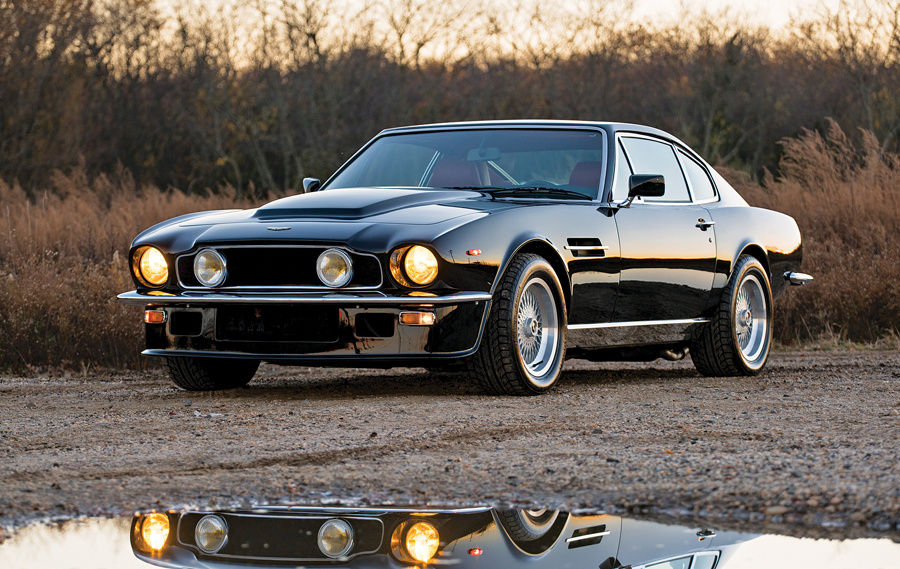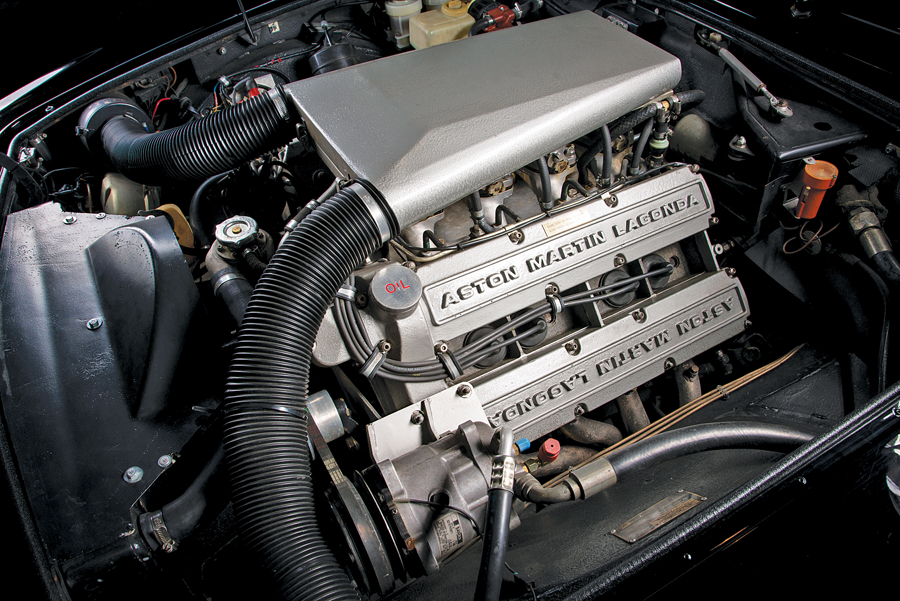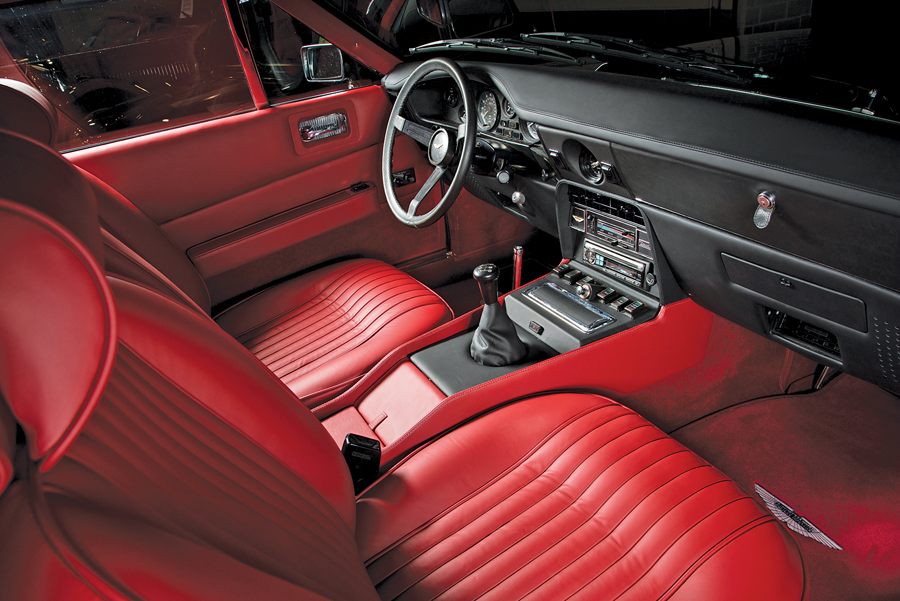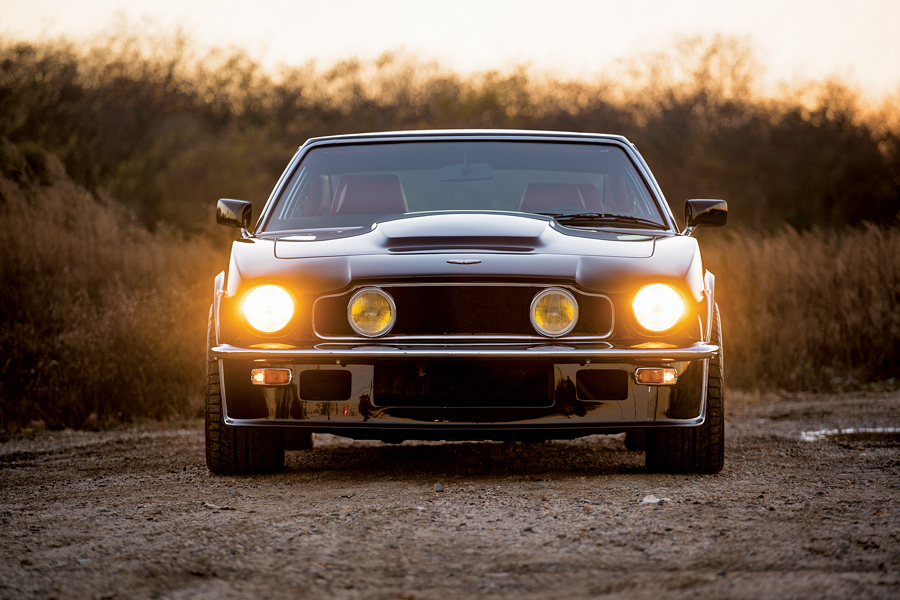The true Vantage “supercar” version of Aston Martin’s standard-bearer V8 was never sold new in the United States due to emissions regulations; the fire-breathing “4×2” Weber carburetors and low-restriction exhaust were simply not compliant. So this first-generation V8 Vantage was rare then, and this now-federal-emissions-exempt example is one of only a few existing today in the United States.
Beginning in October 1978, these cars gained improvements to their body styling, including the trademark Vantage aerodynamic package, a leather headliner, and a burled walnut dashboard as part of the so-called Series II or “Oscar India” generation (“OI” was internal code for the new model, referring to “October Introduction”).
One of the 172 genuine 425-horsepower V8 Vantage models produced between 1978 and 1985, the car offered here was one of the first dozen built in 1979 and was originally delivered to a doctor in Halesowen, England. According to the current owner, it was subsequently sold in 1987 to Viscount de Farcy of France and was professionally converted from right-hand drive to left-hand drive by a well-known Aston Martin specialist. Later it was sold to Count Audoin de Dampierre, a noted Champagne manufacturer, and previous president of the French Aston Martin Owners Club, who drove it some 30,000 miles before selling it to the next French custodian in 1998. A Swiss Aston Martin enthusiast acquired the car in 2001 and added another 12,000 kilometers over the next dozen years.
More recently, the V8 Vantage underwent a complete chassis renovation, bare-metal repaint and complete servicing at Steel Wings of Pennsylvania, including an installation of their own upgraded suspension with shock absorbers and anti-roll bar, plus the addition of updated Ronal-type factory wheels. The body was stripped to bare metal and given a concours-quality repaint to better-than-new condition, all brightwork was reconditioned, and, more recently, the interior was reupholstered in red leather, including a factory-optional leather headliner and correct trunk liner. The engine was resealed and fitted with new water pump, oil lines and oil coolers, and the engine bay detailed, all in spring of 2015.
Accompanied by a copy of its factory build sheet, a comprehensive history file, a factory owner’s manual, and two sets of keys, this is a splendid “true Vantage,” worthy of a new home in any Aston Martin collection, where its performance will continue to astonish.
SCM Analysis
Detailing
| Vehicle: | 1979 Aston Martin V8 Vantage “Oscar India” coupe |
| Years Produced: | (“Oscar India” Vantage) 1978–86 |
| Number Produced: | 291 |
| Original List Price: | 26,000 GBP |
| SCM Valuation: | $181,092 |
| Tune Up Cost: | $1,500–$2,500 |
| Distributor Caps: | $85 |
| Chassis Number Location: | Chassis plate inside the driver’s door jamb (U.S. delivery), on another plate inside the engine bay right side and also stamped on the right side front chassis rail |
| Engine Number Location: | Rear top side of engine block near bellhousing surface |
| Club Info: | Aston Martin Owners Club |
| Website: | http://www.amoc.org |
| Alternatives: | 1971–72 Ferrari 365 GTC/4, 1986–90 Jaguar Lister XJS coupe, 1966–76 Jenson Interceptor coupe |
| Investment Grade: | C |
This car, Lot 234, sold for $308,000, including buyer’s premium, at RM Sotheby’s auction in Phoenix, AZ, on January 20, 2017.
Full disclosure: I was surprised when I was asked to write this profile. I’m not a doctor, a count or champagne manufacturer, and I am most certainly not Stephen Serio, which is good, I suspect, for every possible situation except writing an Aston Martin profile.
So, the only reason I can think of how I got this assignment is that our almighty Editor, Chester Allen, really likes fish out of water even more than his authoring books on that process would suggest.
But hey, I’m not totally ignorant about V8 Vantages. I like them. I’ve driven a few and even inspected this one on-site at the auction prior to this sale. So, to borrow a line from so many Darwin Award recipients who have preceded me on similar ventures, with likely similar results, “Here we go!”
Hotter and faster than the one before
I’m going to go out on a limb and make some comparisons here. The introduction of the new-for-1978 Vantage V8 was the continuation of a theme, much like the XJS was of the E–type — or a GT500 KR is of the original Shelby Mustang. Sorry, couldn’t resist that last one.
However, unlike my comparison examples, the Vantage actually offered improved performance, in the bigger sense, over its predecessors. It was faster (for a time more so than anything else, even the Ferrari Daytona), and was more athletic on a whole than its size would suggest. That can’t be said for the Shelby, which only gained comfort and straight-line speed yet suffered everywhere else; or the XJS that became a very rapid grand-touring car with sporting intentions, rather than the other way around like an early E-type.
Many, including the magazines of the time, considered the Vantage to be the U.K.’s first supercar — as did Aston Martin, obviously. With a 0–60 mph time in the low five-second range and a 170-mph top speed, it was unquestionably the fastest 4-seat production car available, a detail not lost on the motoring press. The Vantage V8 was the car we all hoped the XJS would be, and it was a worthy recipient of the Vantage name.
So there’s clearly good reason the V8 Vantage has always appealed to many people — including me. They are equal parts muscle car, sports car and grand-touring machine. And while I haven’t experienced a “true fire-breathing” Oscar India Vantage, I thoroughly enjoyed the lesser, U.S.-spec-neutered versions I have driven —even the one with a 727 Chrysler TorqueFlite automatic.
I’m also partial to their muscular looks — and the Vantage’s power bulge hood and integrated ducktail spoiler. Adding to the attraction is that, for years, they’ve been modestly priced.
But clearly, that’s changing. As mentioned, I viewed this Oscar India example at the auction. The color, stance and 5-speed intrigued me as well as its “true” OI Vantage specification.
A “tweener” with mods
Upon inspection, however, this car’s condition could best be called “tweener.” It isn’t restored, nor is it original in any area that matters. It is a car that has been enjoyed with spot restoration and maintenance performed piecemeal as needed. Mind you, there is nothing wrong with this “rolling restoration” approach, but the end result differs from a comprehensive, bare-shell-out restoration in many details. The upgrades, while highly desirable from a driving perspective, are not to a purist.
But the real kicker lies in the LHD conversion. My go-to Aston Martin expert, Mr. Serio, commented, “In today’s market with everyone looking for 100% originality down to the British air in the tires, any RHD to LHD conversion is the kiss of death — 98% of the buyers will walk.”
Further poking around on the Internet shows that this car is no stranger to the market or ownership changes. The later history not mentioned in the auction catalog shows that after the 1998 French ownership, it went to a Swiss owner in 2001. That owner added another 12,000 kilometers (7,456 miles) to the odometer. Then AM dealer Tom Papadopoulos imported it to the U.S. in 2012, eventually selling it in 2013 through his Autosport Designs to John Littlechild of New England. I found no further ownership history listed, so it is quite possible that Mr. Littlechild was the seller at RM Sotheby’s, but prior to this it appears that the car was offered online in 2016 through another dealer with an asking price of $395k.
So while a “pure” LHD Vantage V8 Oscar India would likely bring a significant premium over this result, one certainly can’t argue that at this price, even with its LHD conversion and modifications, it still offers the proper Vantage V8 supercar experience.
Today it is well sold, but given the production numbers of Oscar India examples and the market at large, we could be on the cusp of this sale being solidly in the buyer’s favor, especially if he or she elects to drive it in the interim as the count did between champagne factories and AM Club meets.
To my mind, that is pretty much what all Aston Martin owners do, right?
Please direct all excited and opinionated responses to Executive Editor Chester Allen at SCM World HQ. Thank you. ♦
(Introductory description courtesy of RM Sotheby’s.)



